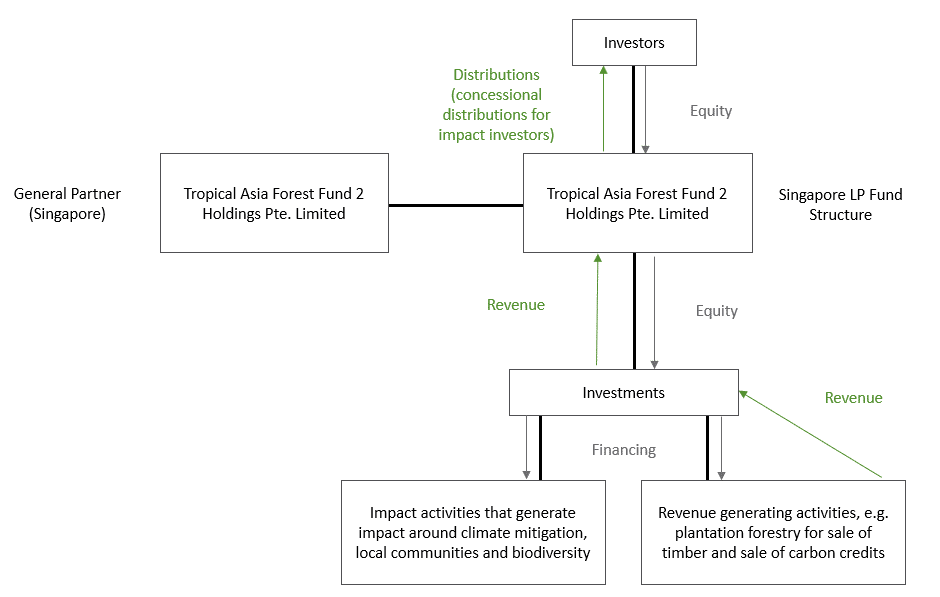| Title | New Forests Tropical Asia Forest Fund 2 |
| Country/Location | Singapore |
| Size | First close $120m; continuing to raise capital |
| Revenue Model | Sustainable forestry and carbon sales in Southeast Asia |
| Private Investment/Finance Structure | Private closed end fund with blended finance model of commercial and concessional, impact-oriented equity |
| Env/Social Impact | 18 impact activities focused on climate change mitigation, biodiversity enhancement and community development |
Summary
The Tropical Asia Forest Fund 2 (TAFF 2) aims to capitalise on the long-term investment opportunities in sustainable plantation forestry, demonstrating how to deliver carbon credits alongside the sustainable production of traditional commodities, such as timber and rubber. The Fund plans to develop a diversified portfolio of plantations across Southeast Asia, using a blended finance structure of commercial and impact investors, ranking pro rata, with different rates of return.
Asia has the world’s fastest growing demand for wood products and Southeast Asia’s forestry sector typically produces higher risk-adjusted returns than mature forestry markets. At the same time, overexploitation of Southeast Asia’s natural forests has led to declining natural forest supply and production volumes. A lot of new investment is required in sustainable plantation forestry to meet rising regional demand over the long term and create positive climate, community and biodiversity impacts.
Despite the potential financial, environmental and sustainable development benefits of sustainable forestry investment in Southeast Asia, institutional investment has lagged in the region due to limited track record and perceived risks. However, New Forests, a global forestry investment manager, has been operating in Southeast Asia since 2008, investing in sustainable forestry, climate finance, and impact in various countries across the region.
New Forests’ Tropical Asia Forest Fund 2 (TAFF2), a new closed end fund, aims to invest in these opportunities. The fund, which had its first close in March 2022 with US$120 million of commitments, will invest in a diversified portfolio of sustainable forest plantation assets in Malaysia, Indonesia, Vietnam, Thailand, Laos and Cambodia for end markets such as timber, rubber and carbon. It will also manage those investments to implement 18 different impact activities, closely linked to the Paris Agreement and the UN Sustainable Development Goals, focusing on climate mitigation, biodiversity enhancement and community development.
Blended finance
Most importantly, it’s the first sustainable forestry fund in the region to have a blended structure, with commercial and concessionary capital, with the objective of mobilising more high-impact social and environmental investment from both groups. “Impact investors are basically getting impact at scale by leveraging the capital commitments of the commercial investors, while the commercial investors have the opportunity to invest in impact at a greater scale than they could with a conventional fund, but are compensated for doing so with impact-oriented investors’ equity,” says Radha Kuppalli, Managing Director, Impact and Advocacy, at New Forests.

Radha Kuppalli, Managing Director, Impact and Advocacy, New Forests Asset Management
Investors in the first close include Asian Development Bank (ADB), the Australian Government’s Climate Finance Partnership, David and Lucile Packard Foundation, Sumitomo Mitsui Trust Bank (SuMi TRUST), GenZero (a Temasek-owned entity) and TotalEnergies. New Forests will continue to raise capital for TAFF2 throughout 2022 and 2023, anticipating a final close in mid-2023, with a goal of raising US$300 million.
New Forest co-created the fund’s structure with the David and Lucile Packard Foundation, which invested in the impact tranche, as did some other investors such as the Australian Government. The fund has so far attracted approximately US$50 million of capital for the impact tranche, which was more than New Forests anticipated. “We weren’t sure when we embarked on this process what the reception would be, but it’s been very positive. It’s taking advantage of the fact that different investors have different objectives,” says Kuppalli.
Kuppalli says that there is no difference between the Class A and Class B units of the fund, offered to commercial and impact investors, respectively, other than the return they generate. She says that New Forests didn’t want to create the perception that the fund needed a first loss facility because of the risk, when it didn’t.
“Regardless of whether you’re a commercial investor or an impact-oriented equity investor, everyone is investing pro rata in both the fund’s commercial and impact activities,” says Kuppalli. “The only difference is that the majority of distributions will go to class A investors, so they get their commercial rate of return”. She adds that commercial returns for forestry investments in the region are normally 12% to 16%. “Class B investors might get more like a 4% to 8% return, depending on the performance of the fund,” she says.
New Forests, which is headquartered in Sydney and was acquired by Mitsui and Nomura in May 2022, has plenty of experience in sustainable forestry in the region, which is complex and requires substantial due diligence. New Forests first sustainable forestry fund devoted to Southeast Asia, Tropical Asia Forest Fund (TAFF), which started investing in tropical hardwood plantations, conservation areas and timber processing in Indonesia, Malaysia and Laos in 2012, was the first dedicated institutional timberland fund in Southeast Asia.
A focus on impact investing
Although its first fund was also involved in impact investing, the new fund, TAFF2, will have a much bigger focus on this and the fund’s impact objectives are a critical part of the evaluation of all the investments that the fund is currently considering. An amount equivalent to 50% of the Class B capital commitments will be spent on impact activities during the life of the fund, with climate mitigation being a particularly big focus.
The 18 different impact activities include forest protection, habitat enhancement and revegetation, but also community development training programs and enhanced benefit sharing schemes. New Forests says it will apply a rigorous ESG approach and certify asset management to international standards. “We will also be reporting to investors on a very regular basis on what the plan is for our impact activities and what the progress is,” says Kuppalli.
Overall, New Forests’ objective with TAFF2 is to demonstrate that asset management that integrates commercial forestry investments with activities like ecosystem restoration, reforestation and community forestry will lead to better returns, alongside long-term sustainability outcomes.
Returns from carbon
The vast majority of the fund’s financial returns will be created through sustainable timber production, particularly of higher value end products, such as furniture and flooring, and improved forest management, governance, timber marketing and processing. However, the sale of carbon credits will also contribute to the fund’s financial returns. “Carbon will absolutely be part of the fund investment thesis,” says Kuppalli. “We estimate that we will probably generate something like 10 million tonnes of carbon over the life of the fund, particularly if we do one or two REDD+ projects, which is part of the fund’s mandate.”
New Forests could also consider bolstering financial returns with other nature-based solutions, which is something the investment manager has experimented with before. “In 2010, we created a biobank in Sabah, Malaysia, with the idea of selling voluntary biodiversity credits into the oil palm supply chain,” says Kuppalli. “I think that idea was probably 10 years ahead of its time and there wasn’t a robust market, but it’s exactly those kinds of ideas that could bear fruit now, whether that’s part of TAFF2 or more broadly at New Forests.”
The big question is whether other fund managers can use the structure of New Forests’ fund as a model to bolster sustainable forestry investment in the region. Kuppalli says that governments, development finance institutions and others are all talking about the need for more blended finance vehicles. “The question in my mind is how do we scale this up? It’s going to require asset management firms thinking more creatively about structures. It’s going to require larger pools of capital, with flexible mandates, from public finance, and asset owners with a greater appetite to invest in emerging markets,” she says.
Sources:
Interview with Radha Kuppali, Managing Director, Impact and Advocacy, at New Forests
Financing Nature Podcast – ‘Episode 13: Radha Kuppalli, Managing Director, Impact & Advocacy, New Forests Asset Management’
